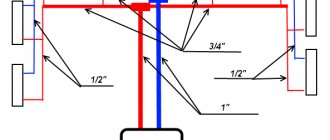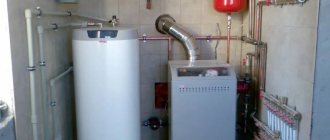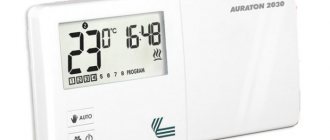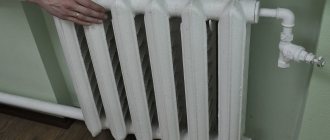Winter is just around the corner. In some regions of the country the air temperature has already reached zero. The cold will come very soon, and with it the heating season. However, warm radiators do not guarantee a comfortable room temperature. Often precious heat goes outside. There may be several reasons for this problem. And it’s better to determine them before the start of the heating season, because it’s not for nothing that folk wisdom says, “Prepare a sleigh in the summer, and a cart in the winter.”
The houses we live in are often insufficiently energy efficient. This applies to modern apartment buildings, Soviet buildings and individual housing construction. Energy for heating a home is required several times more than in EU countries. As a rule, frozen households see salvation in installing additional heaters, most often electric. But such a decision only leads to increased utility bills. It turns out that the consumer buys more heat than he ultimately gets. It's unpleasant, isn't it?
Causes of heat loss in the house
Before moving on to active measures to insulate your home, you should understand the possible causes of heat loss.
- Leaks in wall panel joints.
- Leaks in door and window units.
- Poor quality finishing of external walls.
- The integrity of the roof is compromised (including the junction of the roof with the protruding elements of the building).
- Poor quality drainage system from the roof and blind area.
- Faulty supply and exhaust ventilation system.
- Faulty thermal insulation of communications.
- Poor performance of the heating system - low-power heating boiler, old radiators.
These are the most common problems that home and apartment owners encounter. If at least one of the problems is detected, it should be eliminated immediately.
Insulation of ceiling and roof
This method applies to a greater extent to the insulation of a private house. It is better to insulate the ceiling from the attic side, using mineral wool. It is important not to neglect steam and waterproofing. If the budget is modest, you can use expanded clay or sawdust for insulation, which must be impregnated with fire retardants for fire safety purposes.
According to physical laws, warm air tends to rise upward, so the roof also needs insulation. Its technology will depend on the type of roof. A pitched roof must be insulated from the inside with mineral or glass wool. A flat roof is insulated from the outside with rigid materials that are not afraid of harsh weather conditions.
How to keep your apartment warm
According to current standards, the temperature in the living room must be at least 18°C. Many will agree that this is not enough for a comfortable stay in the room. To ensure warmth and comfort in your nest, you will have to make some efforts. So, what to insulate and with what?
Walls
Traditional building materials, such as brick, concrete, reinforced concrete, can reliably protect housing from heat loss. But only with very large wall thicknesses. The cost of production, delivery and use of building materials is very high; the construction of thick walls is not economically feasible. Therefore, to reduce heat loss we have to look for other methods.
To prevent the wall from taking heat from the radiator, you need to install a protective screen made of ordinary foil between them. Due to this, the heat will be reflected and remain inside the apartment. The size of the shielding foil should be slightly larger than the dimensions of the battery. Heat loss when installing a protective screen will be reduced by 3%.
There is a more radical method of reducing heat loss through walls - thermal insulation. Experts say: insulating the external walls of an apartment will be much more effective. In addition, this allows you to carry out any finishing work, while living conditions and the area of the interior premises will remain unchanged. Insulating a wall in an apartment from the inside is also possible, but such work is accompanied by many inconveniences.
Entrance door
A lot of heat also escapes through the entrance group. A massive door is the key to a warm apartment. It is not necessary to make new purchases. To avoid big expenses, you can insulate the old door, for example, upholstering it with leatherette with a foam rubber gasket. If there are gaps between the wall and the door, they need to be sealed with polyurethane foam and plastered.
If you plan to buy a new door, then it is better to leave the old one too. This way you get two doors with a heat-insulating air layer between them. Measures to insulate and replace the door will reduce heat loss by 1.5%.
Window
Insulating windows is a long-standing tradition for residents of our latitudes. An increase in temperature of 1-2 degrees is possible! All joints between frames and sashes are sealed with cotton wool, foam rubber or tow and sealed with masking tape or, in the old fashioned way, with paper. You can also use foam rubber with adhesive tape or rubber sealing. These materials are perfect for eliminating loose closing of frames and sashes.
A successful solution to reduce heat loss is to install heat-shrinkable energy-saving film on the frame, parallel to the glass or double-glazed window. Thermal film is installed from the inside. It creates an additional heat-insulating layer and prevents heat loss.
Sometimes even replacing old wooden windows with plastic ones does not solve the problem of heat loss. There can be many reasons. The most common of them are: incorrect adjustment, poor-quality seal, leaky fit of the window sill and slopes. You can fix the problem yourself or call a specialist.
Insulating windows will reduce heat loss by 3-5%.
Furniture
Proper placement of furniture is also important in terms of heat conservation. You can protect yourself from an unheated wall using an ordinary cabinet, simply by isolating it from the source of cold. But it is not recommended to place any furniture near the radiator, as this prevents the spread of warm air throughout the room. The same applies to heavy thick curtains on the windows. They simply do not let heat into the room.
Perhaps, in order to enjoy the warmth, it is enough to reconsider the interior.
Insulation of walls and floors
If you insulate the floor, its surface will have a more comfortable room temperature. Your feet will stop freezing, and the air will cool more slowly.
As for walls, insulation can be both external and internal. External insulation is preferable, since internal insulation has a number of disadvantages:
- it leads to a reduction in the usable area of the room;
- the walls will still be cold;
- low wall temperatures are fraught with condensation accumulation, dampness and mold.
You need to insulate the walls from the outside with a material that is suitable for a brick, block or wooden house.
Useful tips
- Open the curtains and let the sun into your apartment! During daylight hours in clear weather, this will help raise the temperature by a couple of degrees.
- Lay a carpet on the floor - this is an excellent barrier to cold air and an additional layer of insulation.
- Leave the door to the bathroom open after water procedures - warm air will fill the neighboring rooms and make them a little warmer.
- Use a fan - direct the air flow towards the radiator, this will help the heat spread throughout the room faster.
- Don't rush to close the oven after cooking dinner - use warm air to heat the kitchen.
- Close interior doors - do not allow heat to escape into a room where no one is present.
Winter is just around the corner. Preparing your home for severe frosts will help you comfortably survive this period without additional unwanted expenses. How do you prepare for winter?
Saving on hot water
The condition of your plumbing directly affects the size of your utility. If the mixer leaks, water losses can amount to up to 300 liters.
It would be good if, instead of a regular toilet cistern, a cistern with an economical flush would be installed. If you place a bottle filled with water in the tank, the water drain per day will be 20 liters less. Use the European method of washing dishes. Clear plates, forks and spoons of food debris. Collect dishes in the sink by plugging the drain. Arm yourself with detergent and start washing. Pour clean water into a separate container and rinse the dishes in it. This way you will reduce water losses several times. It’s even better to buy an economical dishwasher, which, by the way, uses only cold water.
If your shower head has smaller holes, the water savings will also be significant.
It is better to turn off the water while brushing your teeth. If you open the tap completely, 15 liters of water will flow out every minute. This way you can save up to 900 liters of water per month per person. To avoid doing the same thing every time, you can install attachments on the faucet that automatically turn off the water when you lower your hands.
Replacing old wooden windows with metal-plastic ones
Even if you have installed a brand new metal-plastic profile, this does not guarantee that heat loss will be completely eliminated. The window may be drafty. Use a burning match or just a dampened finger to locate the leak. It can also be indicated by condensation, and in critical cases, frost.
If you have only been using the window for the first year, and there are drafts, it is possible that the installation was not carried out in good faith. You can count on warranty repairs. If the profile has been installed for a long time, it is advisable to adjust the locking mechanism and replace the seal.
Thermal imager models
Previously, thermal imagers had lenses made of germanium or zinc sulfide, which significantly affected their cost due to the high cost of the material.
This makes it possible for many people to purchase any model. those who care about health, warmth and comfort in the home.
The minimum detectable temperature is - 40 degrees C.
The maximum detectable temperature is 330 degrees C.
Seek Thermal Compact
The innovative model is almost ideal to use.
The model is compact in size and fits into a regular clothing pocket.
Quite convenient as a device for remote use.
Solves specialized tasks, such as adjusting shooting modes and editing received images.
A thermal imager will help in diagnosing electrical wiring faults.
This function will prevent short circuit of the wiring.
This model is used as a professional device for detecting heat leakage.
The compact gadget Seek Thermal Compact is used using a mobile application.
The application is downloaded to a tablet or smartphone and connected to the thermal imager.
This model is powered by a mobile phone or tablet.
The thermal imager is compatible with Android.
Seek Therma Shot
With its help, problems of searching and detecting heat leaks can be easily solved.
Overlaying visible and thermal images and combining them is a convenient feature to use.
They also buy it for extreme situations, since it is not susceptible to failure due to its shock-resistant housing.
Also used on construction sites or hard-to-reach areas.
This thermal imager is suitable for stationary surveillance.
The presence of a built-in battery allows this gadget to work up to 4 hours without recharging.
Refers to autonomous independent devices. Does not require connection to a phone or tablet.
If you download the SeekYiew mobile application, images can be broadcast to a smartphone or tablet via Wi-Fi and analyzed and edited.
The thermal imager has a 3.5 inch display. You can adjust palettes, spots and dots on the finished image quite quickly, which is its undeniable advantage.
All temperature conditions are saved in the image, which allows you to see the temperature at another point in the visible image without re-taking it.
Seek Therma Reveal PRO
A model with all the above functions of the Shot thermal imager.
The difference from the previous thermal imager is that this model is equipped with a flashlight, which allows it to be used in the dark
Seek Thermal Reveal thermal imager model
The model is equipped with a battery.
The kit includes a USB cable for charging and data transfer.
This thermal imager has a charger; MicroSD 4 GB and built-in flashlight.
Replacing conventional incandescent lamps with LED or fluorescent lamps
Even the most durable incandescent light bulb will not reduce your bills in any way, because only 10% of the electricity is used for lighting - the rest is lost in the form of heat, which, however, cannot heat the house. Therefore, it is better to buy an expensive, but more economical LED or fluorescent light bulb. This solution will reduce energy consumption by 10 times.
Measures to save thermal energy in schools and kindergartens
In schools and kindergartens, many of the above-described energy saving methods associated with insulating walls, attics and building envelopes can be used.
In addition, you can use the following heat conservation methods.
- Insulation of basements.
- Insulation of floors.
- Arrangement of vestibules.
- Reducing ceiling heights in classrooms.
- Removing vegetation that shades windows will allow rooms to warm up on sunny days.
Let us note that a competent energy audit and thermal imaging inspection of your building and premises can help identify the main sources of heat energy losses and eliminate them.
How to save heat in an enterprise
Auto mode
In your home, you can use programmable thermostats to maintain and regulate the temperature of individual heating devices: underfloor heating or electric and water radiators. Their cost starts from 3 thousand rubles per product.
“These independent devices have a beautiful design and are equipped with a display, while being installed in a standard socket box. The home owner can easily create a heating schedule for every day of the week, taking into account individual preferences and life schedule,” says Maxim Brock, product manager for SmartSpace at Schneider Electric.
Most modern boilers (gas, electric, diesel) also have the ability to connect a room temperature sensor. This allows you to maintain the set temperature with an accuracy of a degree.
“There are temperature sensors that can be programmed by day of the week and time. For example, during the day, while no one is home, you can set the temperature to +16°C, and set it to a comfortable temperature when users arrive from work,” notes Anton Kuznetsov.
“All models of BAXI boilers are equipped with weather-dependent automation and the ability to connect not just a room thermostat, but a room temperature sensor. This not only allows you to make the operation of the boiler as comfortable as possible for the user, but also to use functions such as programming heating and hot water operating modes in daily and weekly mode,” says Andrey Fomin, head of the “product marketing” department of BDR Thermia Rus LLC. .
There are ready-made solutions for remote control of boilers via an application on a smartphone or PC. “Now these technologies are more than accessible both in terms of availability and cost. The user can set the minimum temperature in the room and, before his arrival, command the boiler to warm the room to a comfortable temperature, and upon arrival enter a warm, cozy home,” says Anton Kuznetsov.
Equipping with such a system is optimal when it comes to country houses of non-permanent residence. Thus, the BAXI ZONT H-1B boiler remote control system connects to the Internet via a built-in GSM modem, which makes it independent of Wi-Fi and an Internet router. This boiler can be controlled from any phone, tablet or PC, through free phone applications or a personal account on the website. “Thus, when going to the dacha, you can set the required temperature in advance. Using a convenient graphical interface, you can create a daily and weekly temperature schedule in the house for the most optimal gas consumption,” adds Andrey Fomin.
According to the expert, the demand for remote boiler control systems in the private sector is now very high, especially in houses not intended for permanent residence. The growth in sales of such systems is facilitated by their availability. The cost of equipment starts from 7–8 thousand rubles.
Which insulation materials to choose
Modern seals vary not only in size, but also in the material from which they are made.
There are foam pads, as well as polyethylene foam, polyurethane, polyvinyl chloride (PVC) and rubber. Rubber gaskets, in turn, are divided into self-adhesive and those that are glued with glue.
In some cases, PVC is better than rubber; this material is frost-resistant, less brittle, does not crumble or deform, but rubber wears out less.
When purchasing rubber seals, you should choose the softest ones, as they can withstand repeated deformation.
Which seals are better: adhesive or self-adhesive?
Of course, it is more convenient and faster with self-adhesive material. Peel off the protective film, stick it on the desired surface and you’re done. But there is a very important nuance here: you need to carefully read the expiration date of the glue on the product packaging.
If the expiration date expires, the gasket will not stick or will fall off soon. The self-gluing option is more reliable, you just need to buy high-quality glue.
Silicone sealant is considered one of the best - it is not afraid of moisture and even when dry, it stretches and contracts well. This sealant will hold the seal on the window or door when it is slammed repeatedly.











